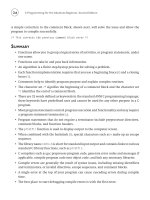Planning Extreme Programming - kent beck martin fowler phần 1 ppsx
Bạn đang xem bản rút gọn của tài liệu. Xem và tải ngay bản đầy đủ của tài liệu tại đây (157.73 KB, 19 trang )
You hold in your hands a draft of Planning Extreme Programming,
to be published in Fall 2000 by Addison-Wesley. Please read and com-
ment.
What we are interested in:
✧
Chapter order
✧
Suggestions for appropriate layout for Bob Martin’s fabulous
Rufus and Rupert story. We intend to intersperse bits of the sto-
ries with the chapters.
✧
More clever quotes to open chapters.
✧
Experiences with the techniques here or variations that worked or
didn’t work. We plan to include little sidebars here and there con-
taining anecdotes, attributed or not as you choose. This is your
chance for fame (without fortune)!
✧
Redundancies where we say over and over all the time the same
thing.
✧
Out and out stupidity.
What we aren’t interested in:
✧
Typos. We have a copy editor. If you can’t help yourself, go ahead,
but our time will be used more efficiently if you leave our crappy
spelling and grammar to the professionals.
Known items yet to be done:
✧
Opening quotes for all chapters
✧
Preces for all chapters
✧
Design of front and back inside covers (suggestions welcome)
✧
More pictures
Chapter 1
To Reviewers
2
Send comments to We prefer annotated
PDF, but we’ll take straight email (note page numbers in your sugges-
tions) or written-on paper. (Send paper to P.O. Box 128, Merlin, OR
97532 USA).
Feel free to pass on the draft to anyone who might read it and com-
ment. We aren’t terribly worried that you will use the text in its current
form and not buy the book when it comes out. If you do, the mistakes
we have deliberately seeded herein will come back to haunt you. Better
all around if you just buy the book when it comes out, hey?
Thanks for your help,
Kent, Martin, and Bob
Copyright (c) 2000, Kent Beck, Martin Fowler, and Robert Martin,
All rights reserved
This is a book about planning software projects. We are writing it
mostly to project managers—those who have to plan and track the cor-
respondence of the planning with reality. We also are writing it to pro-
grammers and customers, who also have a vital role to play in planning
and developing software.
Planning is not about predicting the future. When you make a plan
for developing a piece of software, development is not going to go like
that. Not ever. Your customers wouldn’t even be happy if it did,
because by the time software gets there, the customers don’t want what
was planned, they want something different.
Eisenhower is credited with saying, “Plans are useless. Planning is
vital.” We agree. That’s why this isn’t a book about plans, it’s about
planning. And planning is so valuable and important, so vital, that it
deserves to go on a little every day, as long as development lasts. If you
follow the advice in this book, you are going to have a new problem to
solve every day—planning—but we won’t apologize for that, because
without planning, software development inevitably goes off the rails.
This isn’t a book about the whole of project management. We don’t
cover typical project manager jobs such as personnel evaluation, recruit-
ing, and budgeting. We have stuck to the parts of the process we
know—getting everybody on the team pointed in one direction, dis-
covering when this is no longer true, and restoring harmony.
Extreme Programming (XP) is the programming discipline (you can
use the ‘m’ word if you want to, we’d rather not, thank you) we are
evolving to address the problems of quickly delivering quality software,
and then evolving it to meet changing business needs. XP isn’t just
about planning. It covers all aspects of small team software develop-
Chapter 2
Preface
4
ment—design, testing, implementation, deployment, maintenance.
However, planning is a key piece of the XP puzzle. (For more about
XP, read “Extreme Programming Explained: Embrace Change”.)
XP develops long projects by breaking them into a sequence of self-
contained 1-3 week projects. During each mini-project (iteration),
✧
Customers pick the features to be added.
✧
Programmers add the features.
✧
Programmers and customers write and maintain automated tests
to demonstrate the presence of these features.
✧
Programmers evolve the design of the system to gracefully sup-
port the features.
✧
Programmers finish the features so they are completely ready to
be deployed.
Without careful planning, the process falls apart. The team must
choose the best possible features to implement. The team must react as
positively as possible to the inevitable setbacks. The team must not
overcommit, or they will slow down. The team must not under com-
mit, or the customer won’t get value for their money. The job of the
daily planner is to help keep the team on track in all these areas.
We come by our project planning ideas by necessity. As consultants,
we typically see projects that are mostly dead. They typically aren’t
doing any planning, or they are doing too much of the wrong sort. We
invented these planning techniques as the least project planning that
could possibly help in these situations. You will have to take what’s here
and extend and adapt it to your situation. But if you have no planning,
or planning that is strangling your project, what’s here works for us.
I have a cunning plan.
Baldrick
5
To Reviewers
1
Preface
3
Why Plan?
13
Why We Should Plan
14
What we need in plannin g
16
The Planning Trap
17
Rufus
19
Rufus and Rupert
19
Rupert
32
42
Fear
43
Unacknowledged fear is the source of all engineering
failure.
44
The Customer Bill of Rights.
45
Programmer Bill of Rights
45
6
Driving Softwar e
47
The Problem
51
Balancing Power
53
Top Down Overview
57
Bottom Up Overvie w
61
Balloon Story
63
Too Much to Do
63
Not "Not Enough Time"
64
Cost
67
Four Variables
67
Quality
69
Time and Scop e
70
Shopping For Stories
71
Yesterday’s Weather
73
The Story
74
How it works
74
Scoping a Project
75
Making the Big Plan
77
7
What, Me Worry?
78
Release Planning
79
Who does Release Plannin g ?
81
How Stable is the Release Plan?
81
How Far in Advance Do You Plan?
81
How do you Keep the Release Plan ?
82
How much can you put into a releas e?
82
Release Planning Chapters
83
Short Releases
85
Release Planning Variations
85
Long Releases
86
Small Stories
86
86
Writing Stories
87
Principles of Good Stories
88
Feedback from Estimation
90
Prioritizing User Stories
90
Sizing User Stories
91
Testability
91
Splitting user stories
92
User Story Adornments
93
The story writing proces s
93
When are you done writing user stories?
94
Disposition of user storie s
94
8
Examples of Stories
97
Estimation
99
Estimating the Size of a Story
100
Estimating How Much You can do in an
Iteration
101
The Meaning of Ideal Ti me
102
Improving your Estimate s
104
Ordering the Stories
105
Business Value
106
Technical Risk
108
Worst Things First
108
Performance
109
Negotiating between the two
110
Example Release Plan
111
Measuring Velocity
115
Release Planning Events
115
Changing the Priorities of Stories
116
Adding a story
116
Rebuild the Release Plan
116
Making the First Plan
119
The First Plan
119
Choosing your Iteration Length
120
Iteration Planning
123
Never slip the Date
124
9
Listing the tasks for an iteration
127
Iteration Planning Meeting
127
Technical Tasks
128
Measuring the velocity of a develope r
129
Signing up and estimating Task s
129
Scut Work
131
Too much to d o
131
Too Little To Do
132
Example Iteration Plan
133
Iteration Progress Check
135
Tracking an Iteration
135
When a Programmer finds they aren’t going to make
it
136
When a Programmer has Extra Time
137
Finding you have Too Much to D o
138
Example Iteration Tracking
141
Stand up Meetin g s
145
End Game
147
Deployment
148
Documentation
148
Recovery
151
Principles
152
Recovering an Iteration
154
Recovering a Release
155
10
Regaining Your Balance
155
Visible Graphs
157
Choosing Which Graphs to Show
158
Functional Tests Defined and Passing
158
Production Code Bulk, vs. Test Code Bulk
159
Successful Builds
161
Relative Bug Density
162
Story Progress
163
System Performance
163
How to use the Graph s
164
Your Graphs
164
Dealing with Bugs
165
Dealing with bug reports on deployed softwa re
167
Production Support Team
167
Dealing with critical bugs
168
The Customer
169
Finding a Customer
170
Guiding the Customer
170
The Seed
173
Ready To Commit
175
What about research?
176
Coming
179
Going
179
11
Changes to the Team
179
Splitting the team
180
People growing
180
Tools
181
Fixed scope isn’t fixed
183
Outsourced XP
183
Negotiable Scope Contracts
184
Customer
187
In House Development
187
Contracts
188
Shrink Wrap
189
Missing estimates
191
Red Flags
191
Customers won’t make decisions
192
Defect reports
193
Not going end to end
193
Failing daily build s
193
Customer won’t finish
194
Your Own Process
195
Bibliography
197
12
We plan to ensure that we are always doing the most important
thing left to do, to coordinate effectively with other people, and to
quickly respond to unexpected events.
When Kent was about ten, he went fly fishing for the first time in the
Idaho panhandle. After a fruitless, sweaty day in pursuit of brook trout,
he and his friends headed for home. After half an hour stumbling
through dense trees, they realized they were lost. He started to panic—
fast breathing, tunnel vision, chills. Then someone suggested a plan—
they would walk up hill until they hit a logging road they knew was up
there. Instantly, the panic disappeared.
Kent was struck at the time of the importance of having a plan. With-
out the plan, he was going to do something stupid, or just go catatonic.
With the plan he was calm again.
Plans in software can work the same way. If you know you have a
tight deadline, but you make a plan and the plan says you can make the
deadline, then you’ll start on your first task with a sense of urgency, but
still working as well as possible. After all, you have enough time. This is
exactly the behavior that is most likely to cause the plan to come true.
Panic leads to fatigue, defects, and communication breakdowns.
But we’ve also seen plans lead to trouble. They can be a huge time
sink dragging days out of people who’d rather be doing something pro-
ductive, they can be used as a stick to beat people with, and worst of all
they can conceal trouble until it’s too late to deal with it.
Chapter 3
Why Plan?
14
Why We Should Plan
First, we don’t plan so we can predict the future. Business and soft-
ware are changing too rapidly for prediction to be possible. Even if it
was possible to predict what we needed in three years, it wouldn’t nec-
essarily help because between now and then we need so many different
things.
The more obvious it is that you should do something, the more
important it is to ask why. Clearly you must do some planning when
tackling a serious software development project. Therefore before you
start planning you have to understand why you need to it. Without that
answer how can you tell if you succeed?
We plan because:
✧
We need to ensure that we are always working on the most impor-
tant thing we need to do.
✧
We need to coordinate with other people
✧
When unexpected events occur we need to understand the conse-
quences for the first two.
The first is the obvious reason for planning. There’s nothing more
frustrating than working hard on a part of the system, only to find that
it doesn’t really matter and gets scrapped in the next release of the sys-
15
tem. Time spent doing one thing is time not spent doing something
else, so if that something else is important then we may fail.
Say it’s two o’clock and we’re in Boston. We want to drive up to Aca-
dia, but we’d also like to get haircuts and hit Freeport for camping gear.
Last time we drove up to Acadia it took us five hours with no stops. So
we see some options. If we shoot straight up to Acadia we can be there
by seven. If we want to stop for dinner on the way, say an hour, and be
there by eight. To get haircuts we’d need another hour, so that would
be nine. Visiting Freeport is another hour. We look at what’s most
important to us, if we want to be fed, equipped, not too late. and care
less about our appearance we might decide to drop the haircut. A plan
helps us see our options.
Coordination is why everyone else wants us to plan. We get a call
from our wives to meet for dinner in Bar Harbor. Since it’s two we
know we can do it if we drive right up, stop in Freeport, and be there
around eight. Software is full of such coordination. Marketing
announcements, financial period ends, or management promises. Plan-
ning allows us to get an idea of what is reasonable.
But planning is only as good as the estimates that the plans are based
on, and estimates always come second to actuals. If we hit a horrible
traffic jam all the planning in the world can’t make that dinner date.
The real world has this horrible habit of intruding on the best laid
plans.
But planning still helps us since it allows us to consider the effects of
the unexpected event. Leaving at two we hit bad traffic and don’t get
to Portland until four-thirty. We know we usually get there after an
hour, so our experience (and plan) tells us to call our friends to put din-
ner back to half-past eight and drop the visit to Freeport. Planning
allows us both to adjust what we do and to coordinate with others. But
the key value is to do this as soon as you know the effect of the event.
Our wives would much rather know about our delay at four-thirty than
at eight, and it would be really annoying to spend time in Freeport and
only later realize that we’ve really screwed up dinner with our Cindies.
(We don’t even want to contemplate the consequences of that, in com-
parison software failures are minor events )
16
What we need in planning
Planning is something that people do at various scales. You might
plan your day's activities. The team plans out its tasks for the iteration
Development and business lay out a plan for the next year. Senior man-
agers develop plans for a large organization. When carrying out the
plan you have to understand the scale in which you plan. If you are
driving from Boston to Acadia, you won’t plan every curve in the road,
but you will want to figure out which roads to take and when to change
from one to another. You’re not going to expect to arrive to the
minute, but we know there is some limit of lateness that requires the
apologetic phone call.
In order to carry out the coordination it’s vital to have an accurate
picture of how far you are along the plan. On a road trip this is fairly
straightforward. You can measure mileage, take into account the nature
of the roads, and come up with a rough schedule with significant points
along the way. If you are very late arriving at Portland, you can easily
tell, and thus estimate the delay in reaching Bar Harbor. Software’s vir-
tual nature again conspires against this property. With all the degrees of
freedom it can be very difficult to find out whether you are 70% done
or 30% done. It’s like taking a road trip where you don’t know whether
you’ve gone 30 miles or 300 miles. Without any frame of reference you
feel uncomfortable. If your dinner date doesn’t know how far you’ve
gone, they’re uncomfortable too.
Therefore any software planning technique must try to regain this
visibility, so everyone involved in the project can really see how far
along a project is. This means that you need clear milestones, ones that
cannot be fudged, and clearly represent progress. They must also be
things that everyone involved in the project, including the customer,
can understand and learn to trust.
Plans are about figuring out a likely course of events, and figuring the
consequences of the inevitable changes. We need different plans, at dif-
ferent scales. Yet all the plans must be both simple to build and simple
to keep up to date. Large and complex plans are not helpful because
they cost too much to build and maintain. Since plans involve coordi-
nation, they must be comprehensible to everyone who is affected by
the plan another reason for simplicity.
17
Finally they must be honest, and make it difficult to anyone, includ-
ing development, to be fooled by reports of progress unrelated to real-
ity.
The Planning Trap
It’s the final paragraph that gives us a hint as to why planning can be
a trap. This is because there is another reason why people plan:
✧
To demonstrate they are in control of events
You’ll notice our pejorative use of the third person for this reason.
Controlling events is an oxymoron: you can’t control events, you can
only control their consequences. And even then the amount of control
you have is limited. Events cause plans to change. Once you hit that
traffic jam then either dinner or Freeport are affected. You can’t just
carry on with the plan and pretend everything is the same. That would
be stupid.
Yet we’ve seen this happen plenty of times. If things don’t go accord-
ing to plan, then the planner is afraid they will be blamed. That fear
causes the determination to say that the plan is still on track. They
might admit to themselves that the plan is off track, but if they make
the plan complicated enough they can even hide that. The key thing is
to say to the outside world that everything is still going according to
plan.
But now the plan is diverging from reality and turning into an illu-
sion. Worse still, the planner spends energy trying to maintain the illus-
tion. Developers gradually lose motivation- if the plan’s an illusion than
why try to follow it?
The hope is that it will all sort itself out in the end. Occasionally that
may happen. More often the gap between illusion and reality grows
until at some point the illusion is unsustainable. At this point things get
ugly. The customer is angry because they have made their own plans
based on the illusion, perhaps made some promises that they can’t
keep. The programmers are angry because they’ve worked hard, done
as well as any programmers could do, but now are being shouted at for
not doing the impossible and making the illusion real.
Event happen and plans change. If things are going exactly according
to plan, that’s usually a sign of trouble. The worst thing that can hap-
18
pen to a project is the divergence between the plan and reality. So don’t
fall into that trap. Keep your plans honest, and expect them to always
change.
Rufus
Your name is Bob. The date is January 3rd, 2001, and
your head still aches from the recent millenial revelry. You
are sitting in a conference room with several managers
and a group of your peers. You are a project team
leader. Your boss is there, and he has brought along all of
his team leaders. His boss called the meeting.
“We have a new project to develop.” Says your bosses
boss. Call him BB. The points in his hair are so long that
they scrape the ceiling. Your boss' points are just starting
to grow, but he eagerly awaits the day when he can
leave Brylcream stains on the acoustic tiles. BB describes
the essence of the new market they have identified and
the product they want to develop to exploit this market.
"We must have this new project up and working by
fourth quarter - October first." BB demands. "Nothing is of
higher priority; so we are cancelling your current project.”
The reaction in the room is stunned silence. Months of
work are simply going to be thrown away. Slowly, a mur-
mur of objection begins to circulate around the confer-
ence table.
His points give off an evil green glow as BB meets the
eyes of everyone in the room. One by one that insidious
stare reduces each attendee to quivering lumps of proto-
Chapter 4
Rufus and Rupert









